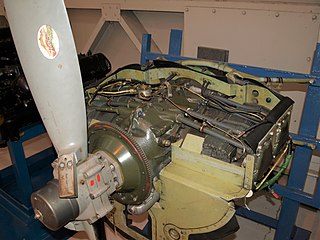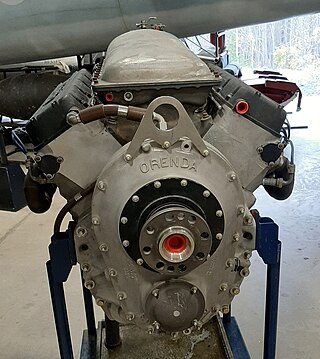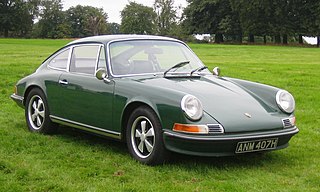
The Thielert Centurion is a series of diesel cycle aircraft engines for general aviation originally built by Thielert, which was bought by Aviation Industry Corporation of China's Tecnify Motors subsidiary and is currently marketed by Continental Motors. They are based on heavily modified Mercedes-Benz automotive engines.

The Mooney M20 is a family of piston-powered, four-seat, propeller-driven, general aviation aircraft, all featuring low wings and tricycle gear, manufactured by the Mooney International Corporation.

The Continental C90 and O-200 are a family of air-cooled, horizontally opposed, four-cylinder, direct-drive aircraft engines of 201 in³ displacement, producing between 90 and 100 horsepower.

The Pratt & Whitney R-985 Wasp Junior is a series of nine-cylinder, air-cooled, radial aircraft engines built by the Pratt & Whitney Aircraft Company from the 1930s to the 1950s. These engines have a displacement of 985 in3 (16 L); initial versions produced 300 hp (220 kW), while the most widely used versions produce 450 hp (340 kW).

The Cessna 175 Skylark is a four-seat, single-engine, high-wing airplane produced by Cessna between 1958 and 1962.

The Lycoming O-360 is a family of four-cylinder, direct-drive, horizontally opposed, air-cooled, piston aircraft engines. Engines in the O-360 series produce between 145 and 225 horsepower, with the basic O-360 producing 180 horsepower.

The Lycoming O-320 is a large family of naturally aspirated, air-cooled, four-cylinder, direct-drive engines produced by Lycoming Engines. They are commonly used on light aircraft such as the Cessna 172 and Piper Cherokee. Different variants are rated for 150 or 160 horsepower. As implied by the engine's name, its cylinders are arranged in horizontally opposed configuration and a displacement of 320 cubic inches (5.24 L).

The Lycoming O-540 is a family of air-cooled six-cylinder, horizontally opposed fixed-wing aircraft and helicopter engines of 541.5 cubic inches (8,874 cc) displacement, manufactured by Lycoming Engines. The engine is a six-cylinder version of the four-cylinder Lycoming O-360.

The aircraft diesel engine or aero diesel is a diesel-powered aircraft engine. They were used in airships and tried in aircraft in the late 1920s and 1930s, but were never widely adopted until recently. Their main advantages are their excellent specific fuel consumption, the reduced flammability and somewhat higher density of their fuel, but these have been outweighed by a combination of inherent disadvantages compared to gasoline-fueled or turboprop engines. The ever-rising cost of avgas and doubts about its future availability have spurred a resurgence in aircraft diesel engine production in the early 2010s.

The Orenda OE600 was a 600 hp-class liquid-cooled 8-cylinder V-block aircraft engine intended to re-introduce piston power to aircraft normally powered by the famous Pratt & Whitney Canada PT6 turboprop. The piston engine offers much better fuel economy, which Orenda Aerospace felt would be attractive for older aircraft whose engines were reaching the end of their lifespan. However, changes in Orenda's business in the post-9/11 market led to the project being canceled.

The Wright R-760 Whirlwind was a series of seven-cylinder air-cooled radial aircraft engines built by the Wright Aeronautical division of Curtiss-Wright. These engines had a displacement of 756 in³ (12.4 L) and power ratings of 225-350 hp (168-261 kW).

The Lycoming O-145 is a family of small, low-horsepower, four-cylinder, air-cooled engines. It was Lycoming Engines' first horizontally opposed aircraft engine and was produced from 1938 until the late 1940s. The family includes the reduction-geared GO-145. The O-145 received its Approved Type Certificate on 13 Jun 1938.

The Continental IO-550 engine is a large family of 9 liter fuel injected six-cylinder, horizontally opposed, air-cooled aircraft engines that were developed for use in light aircraft by Teledyne Continental Motors. The first IO-550 was delivered in 1983 and the type remains in production.
The Lycoming GSO-580 is a family of eight-cylinder horizontally opposed, supercharged, carburetor-equipped aircraft engines for both airplanes and helicopters, manufactured by Lycoming Engines in the late 1950s and early 1960s.

The Lycoming IO-390 engine is a horizontally opposed, four-cylinder aircraft engine, manufactured by Lycoming Engines.

The original Porsche 911 is a luxury sports car made by Porsche AG of Stuttgart, Germany. A prototype of the famous, distinctive, and durable design was shown to the public in autumn 1963. Production began in September 1964 and continued through 1989. It was succeeded by a modified version, internally referred to as Porsche 964 but still sold as Porsche 911, as are current models.

The Lycoming O-435 is an American six-cylinder, horizontally opposed fixed-wing aircraft and helicopter engine made by Lycoming Engines. The engine is a six-cylinder version of the four-cylinder Lycoming O-290.

The Ruschmeyer R 90 is a four-seat light aircraft designed and produced in Germany in the late 1980s and early 1990s.

The Akaflieg München Mü30 Schlacro (SCHLepp-ACRObatic) is a high performance two-seat glider tug and aerobatic aircraft designed and built in Germany from 1985.
The Nelson H-63, known in the US military designation system as the YO-65, is an American dual ignition, four-cylinder, horizontally opposed, two-stroke aircraft engine that was developed by the Nelson Engine Company for use in helicopters and light aircraft. The engine designation means horizontally opposed 63 cubic inch displacement.




















